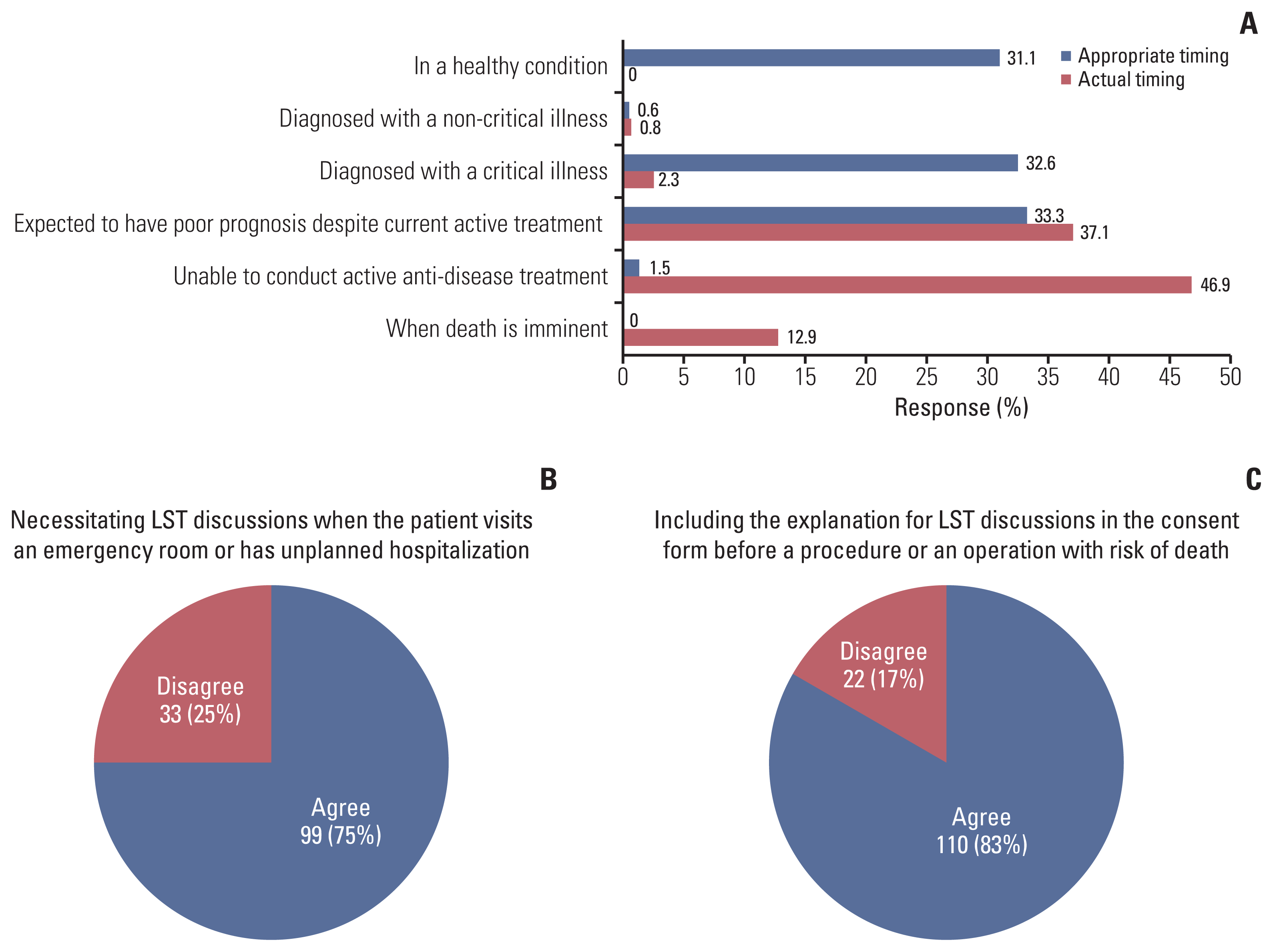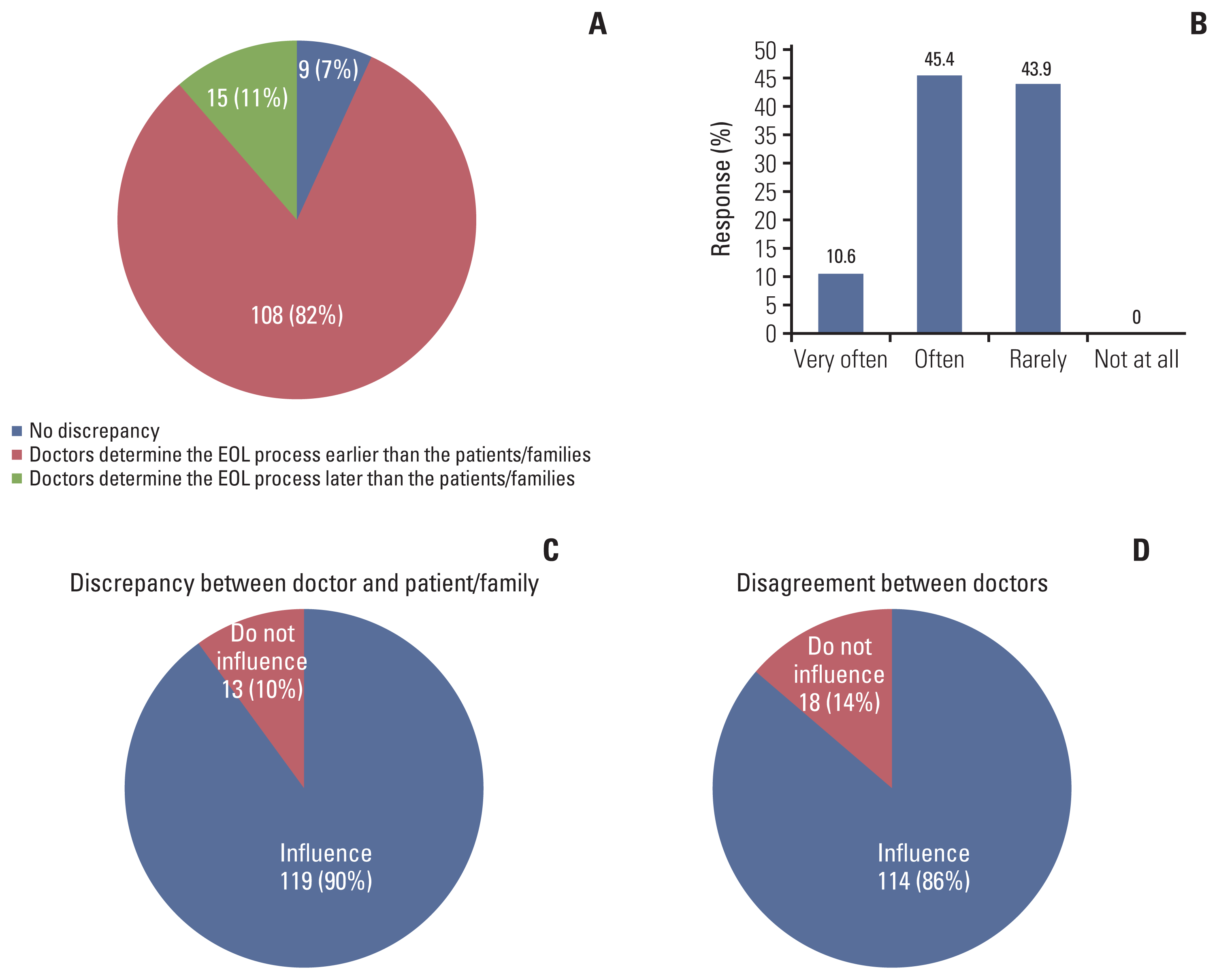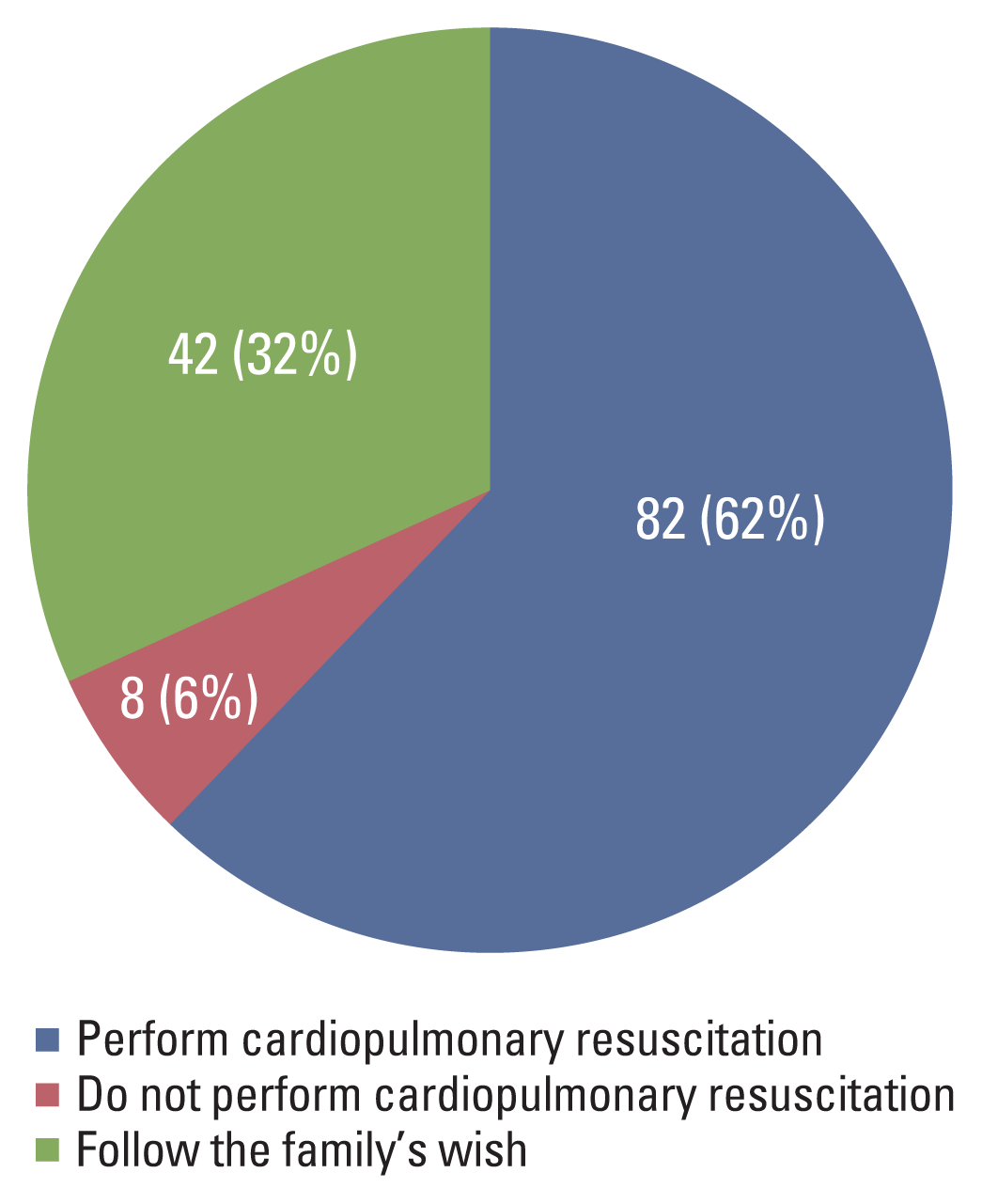1. Singer PA, Martin DK, Kelner M. Quality end-of-life care: patients’ perspectives. JAMA. 1999; 281:163–8.
2. Matsuyama R, Reddy S, Smith TJ. Why do patients choose chemotherapy near the end of life? A review of the perspective of those facing death from cancer. J Clin Oncol. 2006; 24:3490–6.

3. Jho HJ, Nam EJ, Shin IW, Kim SY. Changes of end of life practices for cancer patients and their association with hospice palliative care referral over 2009–2014: a single institution study. Cancer Res Treat. 2020; 52:419–25.

4. Kim DY, Lee KE, Nam EM, Lee HR, Lee KW, Kim JH, et al. Do-not-resuscitate orders for terminal patients with cancer in teaching hospitals of Korea. J Palliat Med. 2007; 10:1153–8.

5. Oh DY, Kim JH, Kim DW, Im SA, Kim TY, Heo DS, et al. CPR or DNR? End-of-life decision in Korean cancer patients: a single center’s experience. Support Care Cancer. 2006; 14:103–8.

6. Baek SK, Chang HJ, Byun JM, Han JJ, Heo DS. The association between end-of-life care and the time interval between provision of a do-not-resuscitate consent and death in cancer patients in Korea. Cancer Res Treat. 2017; 49:502–8.

7. Choi Y, Keam B, Kim TM, Lee SH, Kim DW, Heo DS. Cancer treatment near the end-of-life becomes more aggressive: changes in trend during 10 years at a single institute. Cancer Res Treat. 2015; 47:555–63.

8. Earle CC, Landrum MB, Souza JM, Neville BA, Weeks JC, Ayanian JZ. Aggressiveness of cancer care near the end of life: is it a quality-of-care issue? J Clin Oncol. 2008; 26:3860–6.

9. National Law Information Center. Act on decisions on lifesustaining treatment for patients in hospice and palliative care or at the end of life. Act No. 14013 (August 4, 2017).
10. Lee SY, Seo HJ, Kim S, Eo JS, Oh SC. Prognostic significance of interim 18F-fluorodeoxyglucose positron emission tomography-computed tomography volumetric parameters in metastatic or recurrent gastric cancer. Asia Pac J Clin Oncol. 2018; 14:e302–9.

11. Koh SJ, Kim S, Kim J. Communication for end-of-life care planning among Korean patients with terminal cancer: a context-oriented model. Palliat Support Care. 2016; 14:69–76.

12. Koh SJ, Kim S, Kim J, Keam B, Heo DS, Lee KH, et al. Experiences and opinions related to end-of-life discussion: from oncologists’ and resident physicians’ perspectives. Cancer Res Treat. 2018; 50:614–23.

13. Shin DW, Lee JE, Cho B, Yoo SH, Kim S, Yoo JH. End-of-life communication in Korean older adults: With focus on advance care planning and advance directives. Geriatr Gerontol Int. 2016; 16:407–15.

14. Lee J, Kim J, Kim TS, Kim C. Communication about death and confidence levels concerning death-related issues among Koreans. Korean J Fam Pract. 2019; 9:303–10.

15. Kim JS, Yoo SH, Choi W, Kim Y, Hong J, Kim MS, et al. Implication of the life-sustaining treatment decisions act on end-of-life care for Korean terminal patients. Cancer Res Treat. 2020; 52:917–24.

16. Balaban RB. A physician’s guide to talking about end-of-life care. J Gen Intern Med. 2000; 15:195–200.

17. Kim SH. Preferences for autonomy in end-of-life decision making in modern Korean society. Nurs Ethics. 2015; 22:228–36.

18. Ferrell BR, Temel JS, Temin S, Alesi ER, Balboni TA, Basch EM, et al. Integration of palliative care into standard oncology care: American Society of Clinical Oncology clinical practice guideline update. J Clin Oncol. 2017; 35:96–112.

19. Park IK, Jun HJ, Park SJ, Lim GJ, Cho SJ, Song A, et al. Differences in end-of-life care decision making between patients with and without cancer. Am J Hosp Palliat Care. 2015; 32:797–801.

20. Lee JE, Goo A, Shin DW, Yoo JH. Korean Geriatrics Society End-of-Life Research Group. Korean medical professionals’ attitudes and experiences on advance care planning for noncancerous disease. Ann Geriatr Med Res. 2019; 23:63–70.

21. An HJ, Jeon HJ, Chun SH, Jung HA, Ahn HK, Lee KH, et al. Feasibility study of physician orders for life-sustaining treatment for patients with terminal cancer. Cancer Res Treat. 2019; 51:1632–8.

22. Surbone A. Truth telling to the patient. JAMA. 1992; 268:1661–2.

23. Smith TJ, Swisher K. Telling the truth about terminal cancer. JAMA. 1998; 279:1746–8.

24. Sulmasy DP, Snyder L. Substituted interests and best judgments: an integrated model of surrogate decision making. JAMA. 2010; 304:1946–7.
25. Yamamoto S, Arao H, Masutani E, Aoki M, Kishino M, Morita T, et al. Decision making regarding the place of end-of-life cancer care: the burden on bereaved families and related factors. J Pain Symptom Manage. 2017; 53:862–70.

26. Daugherty CK, Hlubocky FJ. What are terminally ill cancer patients told about their expected deaths? A study of cancer physicians’ self-reports of prognosis disclosure. J Clin Oncol. 2008; 26:5988–93.

27. Fallowfield L, Lipkin M, Hall A. Teaching senior oncologists communication skills: results from phase I of a comprehensive longitudinal program in the United Kingdom. J Clin Oncol. 1998; 16:1961–8.

28. Schroder C, Heyland D, Jiang X, Rocker G, Dodek P. Canadian Researchers at the End of Life Network. Educating medical residents in end-of-life care: insights from a multicenter survey. J Palliat Med. 2009; 12:459–70.

29. Billings ME, Curtis JR, Engelberg RA. Medicine residents’ self-perceived competence in end-of-life care. Acad Med. 2009; 84:1533–9.

30. Mack JW, Cronin A, Taback N, Huskamp HA, Keating NL, Malin JL, et al. End-of-life care discussions among patients with advanced cancer: a cohort study. Ann Intern Med. 2012; 156:204–10.
31. Honiden S, Possick J. Should physicians new to a case counsel patients and their families to change course at the end of life? AMA J Ethics. 2018; 20:E699–707.
32. Vig EK, Sudore RL, Berg KM, Fromme EK, Arnold RM. Responding to surrogate requests that seem inconsistent with a patient’s living will. J Pain Symptom Manage. 2011; 42:777–82.








 PDF
PDF Citation
Citation Print
Print



 XML Download
XML Download